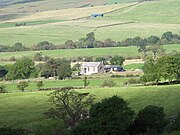North Stainmore
Geography
Stainmore is drained by the River Belah to the west and, to the east, the River Balder, Deepdale Beck, and the River Greta. It is crossed by the Roman road from Bowes to Brough, now part of the A66, and formerly by the Stainmore Railway. Each of these lines of communication has made use of the relatively low broad saddle between the higher hills to north and south which is commonly referred to as the Stainmore Gap. The summit of the former railway is around 420 metres (1,380 ft) above sea level, though the roads climb to slightly higher elevations. The Gap is coincident with the Stainmore Summit Fault which throws the relatively flat-lying Carboniferous rocks of the area down to the south. It acted as a conduit for Lake District-originated ice to pass eastwards during one or more glacial periods. There are several Regionally Important Geological / Geomorphological Sites (RIGS) in the Stainmore area, and Bowes Moor is a Site of Special Scientific Interest. The locality gives its name to the Stainmore Trough, a geological structure originating during the Carboniferous period and which lies between the Alston Block to the north and the Askrigg Block to the south.
History
The place-name 'Stainmore' is first attested in a document of circa 990, where it appears as Stanmoir. It appears as Stanmore in the Charter Rolls for the reign of Henry II, and as Staynmor in the Placita de Quo Warranto of 1292. The name means 'stony moor'.
According to Roger of Wendover, it was where Eric Bloodaxe (d. 954), recently expelled from York, was betrayed and killed, an event which some historians believe to have taken place in a great battle. Ancient monuments include a Roman marching camp at Rey Cross and, immediately east of the camp, the Rey Cross itself (54°30′20″N 2°08′55″W / 54.5056°N 2.14861°W), also called Rere Cross (Scheduled monument, no. 32713).
The Ecclesiastical parish of Brough with Stainmore has two churches: St Michael's, Brough under Stainmore and St Stephen's, South Stainmore. St Stephen's was built by Cuthbert Buckell in 1600 and rebuilt by Henry Tufton, 11th Earl of Thanet in 1842–1843.
Gallery
See also
References
- ^ UK Census (2011). "Local Area Report – Stainmore Parish (E04002574)". Nomis. Office for National Statistics. Retrieved 20 April 2021.
- ^ "Local History: Stainmore (County Durham)". County Councils of Northumberland and Durham. 11 September 2012. Retrieved 14 September 2013.
- ^ Pearsall, W.H. (1941). "The "Mosses" of the Stainmore district". Journal of Ecology. 29 (1): 161. doi:10.2307/2256224. JSTOR 2256224.
- ^ UK Census (2001). "Local Area Report – Stainmore Parish (16UF065)". Nomis. Office for National Statistics. Retrieved 20 April 2021.
- ^ "Kelly's Directory of Westmorland". 1906. Retrieved 2 July 2015.
- ^ "Belah (lower) Water Body". DEFRA. Retrieved 22 November 2024.
- ^ Ordnance Survey 1:25,000 scale Explorer map sheet OL19 Howgill Fells & Upper Eden Valley
- ^ British Geological Survey 1:50,000 scale geological map sheet no 31 (England & Wales) Brough-under-Stainmore
- ^ Eilert Ekwall.The Concise Oxford Dictionary of English Place-names, p.436.
- ^ Roger of Wendover's Flowers of History, Comprising the History of England from the Descent of the Saxons to A. D. 1235 Formerly Ascribed to Matthew Paris, trans. by J. A. Giles, 2 vols (London: Bohn, 1849), I, 256 (s.a. 950) https://archive.org/details/rogerofwendovers01rogemiss.
- ^ "Roman Marching Camp Rey Cross, Durham". Roman-Britain.org. Archived from the original on 19 February 2015.
- ^ "Brough with Stainmoor". Retrieved 20 June 2015.
- ^ "St Stephens Church (Stainmore St Stephen)". Retrieved 20 June 2015.
Further reading
- Collingwood, W.G. (1927), "Rey-Cross" (PDF), Transactions of the Cumberland and Westmorland Antiquarian and Archaeological Society, Series 2 (27): 1–10, doi:10.5284/1063347
- Ramsden, D.M. (1948), From Stainmore to the Tees, The Dalesman Publishing Company
- Richmond, I.A.; McIntyre, J. (1934), "The Roman marching camps at Reycross and Crackenthorpe" (PDF), Transactions of the Cumberland and Westmorland Antiquarian and Archaeological Society, Series 2 (34): 50–61, doi:10.5284/1063141
- Robinson, Pip; Vyner, Blaise (1993), Archaeology on the Stainmore Pass – the A66 Project, English Heritage, ISBN 0 9520836 1 2
- Vyner, Blaise; Robinson, Pip; Annis, R. G.; Pickin, John (2001), Stainmore. The Archaeology of a North Pennine Pass, Tees Archaeology Monographs 1 and English Heritage, ISBN 0 9532747 0 5
External links
- Cumbria County History Trust: Stainmore (nb: provisional research only – see Talk page)







